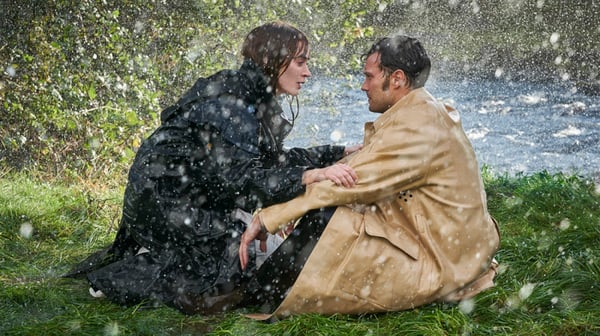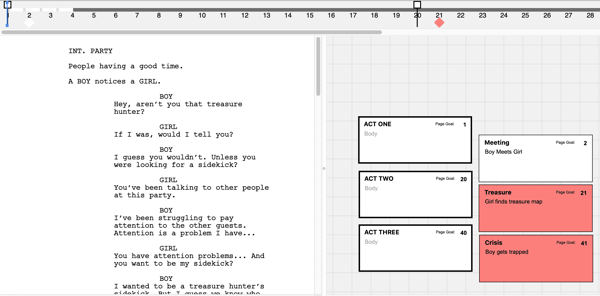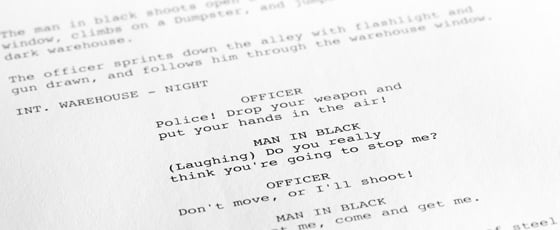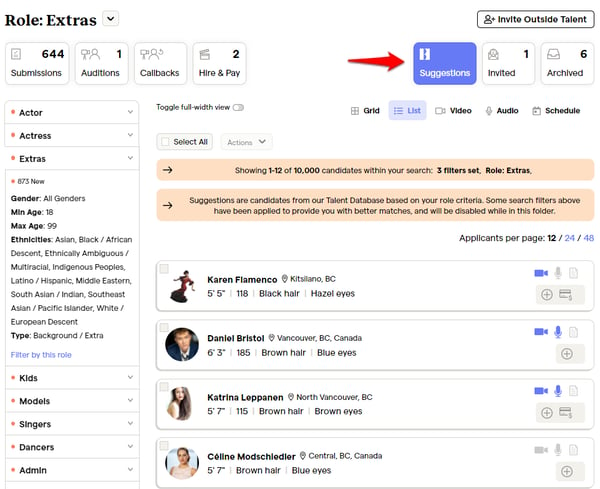How to Write a Screenplay: The Complete Guide
- Guide to Screenplay Genres
- Forming Screenplay Ideas
- How to Write a Pilot or a Feature Script
- Write a Logline
- Screenplay Themes
- Outlining a Screenplay
- Story Structure
- How to Write for TV
- The First 10 Pages
- Writing Scene Transitions
- Flashbacks and Montages
- Editing and Rewriting
- Ready to Sell Your Screenplay
Guide to screenplay genres
When it comes to deciding what genre you want to write in, there are a surprising number of things to consider. Your first concern should be centered on, "What story am I trying to tell?" Sometimes that answer alone will dictate the genre you should write in. But sometimes form follows function and you want to stretch your writing muscles.
So, to get your started, here a few common genres and a scriptwriting guide from a more producorial mindset.
.jpg?width=600&name=avel-chuklanov-Hn3S90f6aak-unsplash%20(1).jpg)
There will always be a market for horror
Horror is one of the most prolific genres out there. People love to watch it; audience seem to have an endless appetite for it, and the return on investment can be massive. Paranormal Activity was made for $15,000 and grossed $161.8 million! People love to be scared.
Romcoms are making a comeback
With the recent success of films like To All the Boys I've Loved Before and Crazy Rich Asians, people are starting to embrace romantic comedies again. This new crop is smarter and more self-aware than their 90's counterparts. If you have a great idea in this space, there are people out there looking for them.
Comedies and straight dramas are tough
Comedies are generally hard to set up without big names attached, in-part because they don't travel well. Comedy is very culturally focused which can limit their appeal. And, since financiers and distributors maximize their profits by maximizing the number of people in theaters, it can be a tough sell unless a major comedian in the lead role is attached.
There are instances when smaller, offbeat comedies breakthrough like Napoleon Dynamite or Rushmore. Something small and quirky can get you noticed, but they're very hard to pull off.
Straight dramas. People tend to shy away from straight dramas because the critical acclaim they engender generally doesn't translate into box office numbers. They tend to do very well in film festivals, but most audiences don't want the unrelenting drama of a Dogville or Melancholia.
These films are popular with actors, but without an A-list start they can be hard to sell and finance.
.jpg?width=391&name=jakob-owens-W0hkz1EnX8I-unsplash%20(2).jpg)
.jpg?width=387&name=judeus-samson-rAomxXulMNM-unsplash%20(2).jpg)
.jpg?width=373&name=david-condrey-jlx4WcHUBJU-unsplash%20(1).jpg)
Westerns
As much as Hollywood loves them, Westerns tend to struggle at the box office. Almost every director will take a crack at one, but not many financiers are actively looking for a Western.
High Fantasy
High Fantasy, which includes sci-fare like Star Wars, tends to be expensive and very risky. If you have an amazing high fantasy idea along the lines of Game of Thrones, The Shannara Chronicles, or The 100, you'll find more traction if it is a pre-existing IP. Pre-existing IP are scripts that existed in a different form first, like a comic book, novel, or podcast.
Forming screenplay ideas
Being creative is hard, often exhausting, work; especially when the life of a writer is churning out content on a consistent basis. You always need to be able to answer these questions, "What's your next project?" or "What's your next screenplay idea?" That's why you should always have an answer ready to go; it's even better if you have a few ideas on deck for an impromptu pitch.
But what can you do to get outside inspiration for film ideas?
.jpg?width=600&name=mark-fletcher-brown-nN5L5GXKFz8-unsplash%20(1).jpg)
Read everything
Books, articles, Twitter, websites... really anything! Take inspiration from people. People are made out of stories, so talk to real people about their wildest ER story, the most random encounter they've had, or their interactions with real live ghosts! Even semi-popular blogs can make an amazing story. The internet is filled with film ideas just waiting to be discovered.
Play games
Many a philosopher have waxed poetic on the boundless imagination of children. Recapture that creativity through games with a storytelling bent. As a bonus, most of these require you to spend time with your friends!
D&D is the OG of storytelling games. Vin Diesel's The Last Witch Hunter was inspired by D&D character. You never know where inspiration could be lurking. Pitchstorm is a fun party game tailor-made for writers and people in the film industry. Filled with absurd prompts and terrible cliches, you never know when the germ of a good film might take root. Once Upon A Time is a creative, collaborative storytelling game that forces you to incorporate certain elements before you can get to The End.
There are also things like story cubes, prompt decks, and online generators that can help jump-start the creative process.
Watch movies, especially bad ones
Almost every movie, whether you consider it "good" or "bad," has the seed of a good idea in it. A theme or storyline your favorite film didn't quite develop could be you next big screenplay idea. That terrible horror movie on Netflix could have an interesting idea that sparks the bonfires of creativity!
Get in touch with your subconscious
It's good to get in a habit of writing every day, even if it's just for 15 minutes. An easy exercise is to write whatever pops into your head, stream-of-consciousness style.
Flip it and reverse it
Hollywood loves "same-but-different" ideas. If you can figure out how to tell a well-worn story from a unique perspective - like flipping the protagonist, point-of-view, or the entire world on your head - you've got a potential hit on your hand.
Research, Research, Research
Is there an area, time period, or subject that interests you? Some random factoid or off-beat claim you heard that might make for fascinating subject matter? If yes, dig deeper. Lose yourself down an internet rabbit hole, ad dig up the forgotten parts of the past like an overlooked inventor or a story of perseverance and resilience that the world's forgotten.
Get out in the world
This is where "life is stranger than fiction" and "write what you know" collide. Be curious about everything around you. Go out and live a little, meet new and interesting people; you never know if that old man reading in the library was once a Hollywood fixer at the height of the Studio System. And, if you can't find something interesting, be the interesting something.
- "If you can figure out how to tell a well-worn story from a unique perspective ... you've got a potential hit on your hand."
How to write a pilot or a feature script
The perennial question: pilot or feature? The answer depends on a lot of factors, including your own appetite and time investment. However, we're going to concentrate on the elements of a story that can dictate the medium and format for you. .jpg?width=600&name=ajeet-mestry-UBhpOIHnazM-unsplash%20(2).jpg)
Features
Feature ideas are contained. Stripped down to their most simplistic form, films have a definitive beginning, middle and end. They’ve got an A-story, and all B or C story lines weave back into, support, and help resolve the A-story. Think about how Loki and Valkyrie’s storylines come together to support Thor’s final battle in Thor: Ragnarok.
Even if you’re writing a franchise or the first in a trilogy, the feature film should stand on its own and come to some kind of satisfying conclusion. That’s not to say every film has to be wrapped up in a bow or unambiguous, but it should satisfy your audience and make sense in the context of the conversation you’re having with your audience like The Favourite or Her.
In addition, a feature has a limited amount of time and space to tell a full-fledged, complete story. At most, that translates into 120 pages and a 2 hour runtime; though most features land around the a 90 minute runtime.
Because of these limitations, films usually only have the bandwidth to focus on one or more complex thing: a complex structure to tell a simple story with simple characters like Memento or complex characters against a simple plot and familiar story like Collateral. So if your story is contained and singularly focused, a spec. feature may be the way to go.
Pilots
On the other hand, TV ideas need an engine behind them; something that propels the story AND characters forward. It needs to keep both audience and characters engaged week after week. This can be an ongoing mystery like Emergence, a job that naturally has procedural elements built in like CSI, or a group of fascinating characters in unique and/or high stakes environments like The Good Place.
Today’s TV landscape is an increasingly complex and challenging narrative. You can leave things open ended, have story points dangling, and themes that are designed to develop over time. With TV, you can take things slower and tease them out in a way you can’t in film.
If you find yourself wanting explore a lot of different themes, identities, characters, and stories, you likely want to write a pilot. But there has to be something in there that carries our attention and investment through for 13 hours or beyond. That’s usually a combination of characters we fall in love with and want to revisit time and again, and compelling situations we follow them through.
Write a logline
The film industry is filled with little quirks and oddities that defy explanation and are almost always confusing at the beginning. We’ve worked with many a writer developing and preparing scripts for market, and one of the most common questions is, “What is a logline? I know I need one, but I just don't know why."
Why loglines are important
Simply put, they’re the shortest summary of your story you can come up with. Ideally, it’s concise, informative, enticing, and only one to two sentences long. (seriously, no more than that). Loglines distill your story down to its most intriguing, base parts and encapsulate the emotion and feel of your script.
Loglines are also an incredibly important sales tool that should never go overlooked. Other than your title, it’s often the first thing a creative executive or producer uses to get a sense of your screenplay, and sometimes it’s the deciding factor as to whether or not someone reads your script.
If you read all that and still find yourself going, “Ok, but how do I write a logline?” don't worry, you aren't alone. For something so short, it holds a lot of sway; so it takes lot of brainpower and consideration to make a good one.
How to write a logline
There’s an art form to loglines, and as with most things, they vary from project to project. But the core of what makes up a good log line is fairly standard.
Generally speaking, a good logline introduces your protagonist, an inciting incident, and hints at where the action is headed. Sometimes you might include the main antagonist or the second lead.
Let’s take the logline for Speed as an example:
A young police officer must prevent a bomb exploding aboard a city bus by keeping its speed above 50 mph.
Protagonist: A young police officer
Inciting Incident: Prevent a bomb exploding aboard a city bus
Action: Keep its speed above 50 mph.
Note that the protagonist’s name isn’t used here. We had no frame of reference for who Jack Traven was before SPEED, so as a marketing and informative tool, it’s more important to highlight the elements we think will entice audiences and studio executives; namely, the ‘young cop’ thrown into a high speed, high stakes situation.
The same rules apply to comedies, as we can see from Napoleon Dynamite:
A listless and alienated teenager decides to help his new friend win the class presidency in their small western high school, while he must deal with his bizarre family life back home.
Protagonist: A listless and alienated teenager
Inciting Incident: Helping his new friend win the class presidency
Action: Deal with his bizarre family life
Even though the main character’s name is the title of the movie, we still take the time to describe the character as opposed to naming him. First and foremost, it’s your characters and the situation that draw audiences in.
Everything about this log line is crafted to whet our appetite for the story about to be told; from including the word “bizarre” to underscore that this is an off-beat comedy, to telling us that this takes place in a small, western town.
We've used film examples because movies movies lean a bit more into loglines than television. It's easier to summarize an encapsulated story than trying to summarize the open-ended, on-going story engine of a TV show.
You’ll find that serialized TV shows tend to summarize the pilot, whereas procedural TV shows focus more on the engine. Let's look at a couple of TV examples.
Lost: After a plane crash, a group of survivors find themselves stranded on a strange, seemingly deserted island where not all is as it seems.
The action element here is a little bit more nebulous than its film counterparts, in part because Lost is primarily about what happens on that island.
Wisdom of the Crowd: Based on the Israeli format of the same name, and inspired by the notion that a million minds are better than one; a tech innovator (Jeremy Piven) creates a cutting-edge crowdsourcing hub to solve his own daughter’s murder, as well as revolutionizing crime solving in San Francisco.
Here, Wisdom of the Crowd has some overlap between the inciting incident and the action, because that’s part of the engine that drives the show forward—we can assume that solving the daughter’s murder is either solved in the pilot episode, or an ongoing story arc for the first season.
Logline tips and tricks
In addition to the structural rules of a good logline, here are a few other things to keep in mind:
- Loglines and taglines are very different; loglines shouldn’t be a question.
- Write them in the present tense.
- Keep them lean and mean – no extra wordage like “this is the story of,” or extraneous information.
- No run-on sentences. It’s hard at first, because our impulse is to cram as much information as possible into our very limited one-to-two sentences, but less is more in this case.
- Mention time period if it’s important to the story.
Practice by writing loglines of your favorite movies and TV shows, then look up the official loglines. What are the similarities? What are the differences? Which movie would you want to watch more, based on the logline? Now do it all over again.
Remember, a good logline can make you stand out from other scripts on the market, and signals to execs and producers that you’re a professional of some caliber and experience.
- "a good logline introduces your protagonist, an inciting incident, and hints at where the action is headed."
Screenplay themes
When we meet with writers to hear their pitches, one of our favorite questions to is what they think their favorite movie is about.
We don’t mean “summarize the events of the story.” We mean, “What’s the meta-text of the story? What gives it meaning? What’s its point of view? What’s it actually about?” What’s the central, unifying concept of the story?"

What is a theme?
Theme is really the engine that drives a story along and gives it meaning. It’s the compass that guides if you ever find yourself not knowing where you to go. It’s rarely expressly, stated, or obvious; it's usually lurking beneath the surface of your story like an iceberg and bolstered by the other elements of your screenplay—character, dialogue, and plot.
Take The Babadook, for example. It's a movie with a very strong, clear central theme: how loss eats away at a family and can destroy it if not dealt with.
If you breakdown the storyline with that in mind, narratively the Babadook becomes the personification of the character Amelia’s trauma of the loss of her husband. It traumatizes her and her son, Sam, until she is forced to confront her loss or die. Ultimately, the Babadook is under control, but never going away. The metaphor is very clear, which gives The Babadook a tight structure and tells us what the happiest possibly ending could be.
Most of the time, the protagonist’s character arc will express or reflect a script’s theme as they go on their journey, but theme can be a bit more nebulous and open-ended as well. Spike Jonez’ Her explores the way humans interact with technology and AI; raising questions, but choosing not to answer them fully. As the main character moves through his relationship with a Siri-like singularity, thematically we’re challenged to question our own assumptions about relationships and technology.
Types of themes
While individual themes get more specific, there are some broad universal categories that are popular movies themes:
- Vengeance / Redemption
- Good / Evil
- Love / Hate
- Coming of Age / Death
- Sacrifice
- Family
- Transformation
Theme is purpose, and often, a lesson. If you find yourself struggling with a tricky section of writing, your theme can tell you where you need to go.
- "Theme is purpose, and often, a lesson."
Outlining a screenplay
Outlining a screenplay is an essential skill to every professional screenwriter. It’s an essential step in the development process, and a good outline can save everyone a lot of time and energy in the long run.

What's in a script outline?
An outline consists of a scene’s most essential information. The scene usually has a location heading and a short summary of the major beats that occur. You can be very meta in outlines, saying things like “There’s an air of palpable tension.” or “Erin starts getting suspicious of Tim.” The details of how this happens will come through in character and dialogue at the script stage; right now, we’re looking more at the bigger picture.
When you get in the habit of outlining a screenplay, you can fix a lot of structural issues before you ever write “fade in.” An outline is a detailed guide, but don’t feel beholden to it. Leave room for inspiration, sometimes your characters will surprise you. A producer or director can help you rearrange scenes more easily in an outline than when you’ve already written the script.
There’s no one-way to format your outline. Some people use the time-honored tradition of index cards. Others use full sluglines, some use roman numerals to indicate scenes changes. The important part is to be clear about when scenes change, and what’s going on in there.
Outline formats
Here’s a short film outline example that demonstrates two ways you can format your outline. As long as you clearly and effectively delineate the difference scenes, you can format the outline however you want.

This is a very short film with no dialogue, but you can see how you get a sense of what the final product will look like. Based on this outline, the writer and producers can talk about whether they see any plot holes, logic gaps, or weak points that need to be shored up. It’s much easier to affect structural change at this point—dialogue and character can be finessed, but structure is always a pretty hefty rewrite that takes a decent about of time.
An outline can save time, and make sure everyone is on the same (script) page.
What is screenplay structure?
Screenplay structure breaks down on both the micro and macro level.
On the macro level, film generally uses a three-act structure. This is the most traditional and accepted screenplay structure. In the three-act story structure, the acts breakdown like this:

ACT I sets up your story, explains anything you need to know, sets up an inciting incident, and a major plot point; the Protagonists has a problem.
ACT II has the lead facing a confrontation, the action rising, the midpoint of the film, and another major plot point; the Protagonist tries to fix the problem.
ACT III will see us resolving the situation, the climax of the story, and the denouement; the Protagonist resolves the problem — for better or worse.
The set up for a film, which encompasses most of Act I, includes an inciting incident (the thing that propels us into the main action) and a major plot point that transitions us into Act II.
Act II is all about confrontation, and broadly can be broken down into to halves: “the good guys do things” and “the bad guys do things.” This leads to the action rising, and generally switches at the midpoint—whomever was ascendant in the first half of the second act should now be on their downswing. That’s a lot to balance, and generally speaking the second act tends to be the hardest to get right. It’s a period of change and action, and it can be easy to lose your characters and focus amidst so much controlled chaos.
Another major plot point signals the start of Act III, which is all about Resolution. The climax of the story happens, after which we wrap up any remaining loose ends.
Page-wise, Act I tends to run about 25-30 pages, with the inciting incident happening by page 15 at the latest. Act II runs until about page 75, and Act III ends within 100-120 pages.
You can practice breaking down your favorite movie, identifying the different parts of the story and figuring out how they all come together. You can also try timing out different act breaks, to see how long each act lasts, and where each different element happens in a feature.
*N.B. TV handles this differently; a one-hour network screenplay shows breaking down into 6 Acts, and half hours breaking down to 3- or 4-Acts to account for commercial breaks.
How to write for TV
Writing for TV shows is a specific skill. It’s not quite like feature scripts, in part because there are different standards based on what kind of show you’re writing.
TV episodes usually have three storylines running simultaneously. The “A” story is the main story, the thing that drives most of the action and take up most of our screen time. The “B” story is usually related to the A story in some way, and sometimes it exists as a juxtaposition. The “C” story gets the least amount of screen time and is usually a storyline we’ll be exploring over the course of a season.
.jpg?width=600&name=james-lee-2xvrgz03cw8-unsplash%20(1).jpg)
Act I: The A story is a debate, some kind of clash. The B and C stories are introduced. The B story is usually something interpersonal that directly affects the A story. The C story is usually a longer runner that will stay with us for the season. It should end with us wondering, “What do we do now?”
Act II: The A story tests the promise of the premise, but fails in some way. Build us up and then frustrate us. Give the audience something to come back to. The bad guys should be closing in at this point.
Act III: Everything deteriorates as the bad guys gain the upper hand. Our all is lost moment comes in here; everything is darkest before the dawn. How are we going to get out of this?
Act IV: We manage to get out of it. Our daring plan, Hail Mary, our last-ditch effort goes into play. It doesn’t quite go to plan and we seem to fail until the B story bears fruit and gives us the key to fixing this mess. The day is saved, and we can sit with the aftermath of our A and B stories.
Act V: The denouement, tying up loose ends, letting our characters breathe, and whetting everyone’s appetites for next week.
This broadly applies to network and basic cable TV. Networks have their own structure requirements; some want 6 acts and a teaser (which one could argue is 7 acts), and some work with 5 acts. Premium networks and platforms like HBO and Netflix don’t have commercial breaks, which means you can write a story without the act breaks.
Once you’ve figured out how your acts break down, and how the A, B and C stories will interweave with one another, you can get down to the business of writing dialogue and building characters.
The first 10 pages
Every screenwriter has probably heard something like “executives know whether they like your project in the first 10 pages.” That’s true, though often it’s shorter than that. So what’s the secret? What are we looking for in those first 10 pages?
Plenty of people have script-writing tips around crafting those first 10 pages, so let’s focus on how to write a screenplay that’ll resonate with the executive or producer who will be reading your screenplay.
.jpg?width=600&name=man-in-white-dress-shirt-sitting-on-black-rolling-chair-840996%20(1).jpg)
Introducing characters
Screenplays are blueprints for images. As such, everything you write in your script should be inherently filmable. The only real exception is introducing a character; you have the opportunity to tell the reader something important about your character that you cannot directly film.
Let's look at an example; a character is introduce as “ALICIA (20s), blonde and pretty,” that's a lost opportunity to tell the reader something interesting and establishing about Alicia. Compare that to, “ERICA (20s), blonde, refuses to give way when she walks.” That’s a fascinating character trait that tells a lot about Erica and will color how she is read going forward.
Building an interesting world
Every story exists in a “world”; a narrow, specific construct that facilitates the story we want to tell. The world of Fargo is different than the world of Three Billboards.
We're often telling a familiar story; it's how you create and dress up that world that makes it stand out. In a typical script, the first 10 pages is usually packed with world building that informs the tone of the movie and tells the audience what kind of experience they’re in for.
Make it easy to understand
In addition to establishing world, tone and character, by page 10 we should have a sense of what your story is about. If someone is still trying to figure out what kind of story they're reading by page 15 at the latest, then you should worried about the structure and pace of your script.
The inciting incident should have already happened, and the reader should be eager to see how the protagonist responds to it.
Make it engaging
Simply put, do people care? Do they want to read past page 10, to see where the story goes and how the characters grow or change? Have you set up an interesting world, populated with complex characters, and the promise of some good action?
As long as people have an emotional connection with your lead, they'll keep turning the page. Making those first 10 pages as dynamic as possible in a way that feels true to the story is the mark of a great writer.
Writing and formatting scene transitions
Scene transitions have largely gone by the wayside in modern screenwriting. Film language and editing techniques have developed to the point where transitions are largely passé. However, they can be a very effective tool when properly, and judiciously, incorporated into your screenplay format.
Most scene transitions are oriented to the right side of the page and written in ALL CAPS with a couple of notable exceptions. Once you know the rules (and how to break them) screenplay formatting can be somewhat elastic. The key is to make sure your intent is clear.
All scene transitions should be used sparingly; too many and you risk “directing from the page.” Make sure it's very clear why these scene transitions have been included and what they add to the story.
.jpg?width=600&name=man-holding-clapper-board-1117132%20(1).jpg)
CUT TO
"CUT TO" indicates a hard, purposeful shift from one scene to another. Every scene change has an implied “CUT TO,” but if included the script it's to emphasize something.
JUMP CUT
A jump cut is two shots of the same scene that only vary slightly, suggesting the passing of brief amounts of time. They are intentionally jarring and frenetic, and audiences are supposed to “notice” it in a way they aren’t with a regular cut. This is the standard way of editing for many internet videos.
There are several ways to write them, the current standard being the list:

You can also use “CUT TO:” before each of those little ‘scenes,’ but that’s fairly excessive and considered archaic.
SMASH CUT TO or SLAM TO
Indicates a much harsher, abrupt transition, with one scene abruptly ‘smashing’ into another. It’s usually a narrative and emotional signifier, but it can become part of the visual language of a work.
FLASH (CUT) TO
A very brief shot—sometimes only a single frame. Rarely, can refer to a series of very brief shots.

This is the most streamlined, modern version. Though you can also incorporate the FLASH into sentence form:
 The traditional way reminds you to go back to the scene, but takes up a lot of real estate on the page:
The traditional way reminds you to go back to the scene, but takes up a lot of real estate on the page:

INTERCUT
The intercut is a specific kind of scene transition. It mostly came about to address how one dealt with people talking on phones, and then mobile phones, because it becomes painful to read a new slug line every time one person talked on a phone call.
INTERCUTS are formatted like an action line, but in ALL CAPS and after you’ve indicated where each of the characters is via separate slug lines.
 You may use INTERCUT AS NEEDED if you’re jumping between separate locations or INTERCUT CONVERSATION if it’s a phone call.
You may use INTERCUT AS NEEDED if you’re jumping between separate locations or INTERCUT CONVERSATION if it’s a phone call.
However, if you want to cut between three or more people/scenes, you should specify whom you’re intercutting between:

MATCH CUT
This is used when the ending image of one scene matches the beginning of the next.
![Screenshot of a script reads: Interior. OFFICE – DAY. Jim yells in frustration and HURLS a KNIFE at the wall. MATCH CUT TO: Interior. THROWING RANGE – NIGHT. Erin tugs a knife out of a target.]](https://info.finaldraft.com/hs-fs/hubfs/5-1.png?width=600&name=5-1.png)
DISSOLVE TO or FADE TO
One scene fades out and the next fades in. A gentler transition that suggests a passing of significant time, and sometimes a level of consciousness; like falling asleep, losing consciousness, or just waking up.
FADE IN or FADE OUT
It used to be that all scripts started and ended with a fade. This has largely gone by the wayside, but some writers like to include it anyway. Many writers say typing “FADE IN” helps them get into the mental headspace for writing or the page is less daunting since it’s no longer blank.
It may be a relic of a bygone era, but there’s something to be said for transition, and no one is going to begrudge you a FADE IN or OUT.
BACK TO
BACK TO is a good way to signal a return to form or the normal flow of your script. If you have a lot of CUT TOs or a longer series.
Flashbacks and montages
Formatting of screenplays hasn’t changed much since they were being written on typewriters and there aren’t many hard and fast rules. Especially about how how to execute flashbacks and montages.
The key to using a montage and/or flashback efficiently is being clear.
- Know why using a montage or flashback is the best choice to convey what you’re trying to say, and how it supports your story/POV.
- Make sure you’ve clearly indicated where the montage or flashback begins and ends.
- Make sure the formatting is consistent across the screenplay.
- Once you know the rules, have fun breaking them.
Let’s address that last point, and go over how to write a montage, as well as writing flashbacks.
How to write a montage
A montage in film acts as a way to ellipse time to pack a lot of information in a short period. Time is precious and a limited resource in television and film, so using it efficiently is key to telling a good story. Montages are a great way to take a shortcut through repetitive martial arts training; developing a relationship from meeting to true love; conveying a specific feeling or emotion; and introducing contrasting characters.
Sometimes, a montage can be as simple as a sentence:
 This is the one to use if you’re just running through a series of something repetitive and the content doesn’t need to be too detailed. You can also bold and/or underline MONTAGE to make it stand out if you prefer, just remember to keep it consistent.
This is the one to use if you’re just running through a series of something repetitive and the content doesn’t need to be too detailed. You can also bold and/or underline MONTAGE to make it stand out if you prefer, just remember to keep it consistent.
If your montage is more complex than a sentence, it’s a good idea to indicate the BEGINNING and END of your MONTAGE (always in ALL CAPS). The development executives and professional readers who evaluate your script will thank you for the clarity.
The List Montage is probably the most common method. And it’s exactly what it sounds like:
 These are a bit more complicated than our other examples, focusing on multiple people, complex actions, and/or taking place in different locations. Trust us, your line producer and 1st AD will thank you if these are properly formatted and slug lined when it comes time to film your montage.
These are a bit more complicated than our other examples, focusing on multiple people, complex actions, and/or taking place in different locations. Trust us, your line producer and 1st AD will thank you if these are properly formatted and slug lined when it comes time to film your montage.
Writing flashbacks
Flashbacks can be a great tool, but like a montage you have to know how to employ them effectively. Flashbacks should keep the story moving; adding information we wouldn’t otherwise get. They have to have a purpose and help raise the stakes for the audience. So know what circumstances trigger a flashback, and keep them as short as possible.
Once you’ve figured out the whys of your flashback, you need to figure out how to format them. They operate similarly to montages from a formatting perspective.
![Screenshot from a script that reads: INTERIOR. Office – present – day Jim yells in frustration and HURLS a KNIFE at the wall. Bold Text FLASHBACK Italicized text: INTERIOR. Throwing Range – 1960 – NIGHT Jim tugs a knife out of a target. Bold Text: END FLASHBACK]](https://info.finaldraft.com/hs-fs/hubfs/4-2.png?width=600&name=4-2.png)
Offset the flashback, clearly indicate its beginning and end. If if you want to further differentiate the flashback, italicize the whole scene.
If the whole scene happens in one scene, you can indicate the flashback at the end of the slug line, like so:

If it’s a quick, self-contained flashback, you can embed it directly into the action:
 This allows the reader to keep to the flow of the scenes, and mimics how it will look to the audience once you edit the scene together.
This allows the reader to keep to the flow of the scenes, and mimics how it will look to the audience once you edit the scene together.
Editing and rewriting your screenplay
Editing & Rewriting
“Writing is just rewriting” and writing screenplays takes this to the limit. The most fundamental piece of advice I can give aspiring and green screenwriters is be prepared to take notes and rewrite, rewrite, and rewrite some more. You are your first editor and rewriter; but when you sell your script, you’ll be taking in the notes and thoughts of other creative partners.
While it’s always helpful to get outside opinions on your work, there are some editing techniques you can use to make your script better.
.jpg?width=600&name=green-chameleon-s9CC2SKySJM-unsplash%20(1).jpg)
Give yourself time away from your first draft
Give yourself a break. You can get very far in your story, so much so that you lose the forest for the trees. Don’t be afraid to set a draft aside for a couple of weeks to a month or two—however long you need to get a little perspective on your work. You’d be amazed at what you pick up on when you’ve got a bit of distance from your first draft.
Run it by beta readers
You should gather notes from a few points of view, from people you trust, whose movie sensibilities you’re familiar with. There’s not a lot of use in running your horror script by someone who hates horror. Look for where their notes intersect, and consider the alternative viewpoints and biases of your readers.
Outline your changes
It’s easier to fix structural problems from an outline or treatment than it is to rewrite an entire 120-page script. Organizing your thoughts by writing down all the changes you want to incorporate can help you organize your approach, and if you’re working with a producer or development executive, ensures everyone’s on the same page with the changes.
A producer will give you notes and help guide you to the most commercially viable story possible. But this collaboration brings its own challenges, and being a good at outlining can help make everyone is happy.
Know which notes to take, and which to leave
A good development executive won’t insist you take all of their notes. They’ll make sense, be coherent across the board, and not contradict one another (or if they do, they acknowledge the contradiction). This isn't always the case though. You have to develop a sense of what notes you should leave behind, which notes you should take, and which you should play with. Sometimes, you have to look at the note behind the note.
Figure out where to dig your heels in—and where to give in
Notes, ideally, should be a collaborative process between you and the creative around you. Ideally, you’re all working in favor of the project, and of a similar mindset, but sometimes that’s not the case. You’ll run into your share of bad notes and takes, and honing your instincts on when to stand your ground and fight for something and when to give way and let something play out will come with experience.
Ultimately, it’s up to you as the writer to make the final call, but remember that this is a collaboration. Sometimes you have to try a note you know will fail to prove to everyone else it’s no good. This can be frustrating, but it’s part of the process.
Be prepared for someone else to rewrite you
The bigger the projects you write, the more likely it is you won’t be the last writer on a project. One of the draws of independent film for writers is they have a little bit more control than in the studio system. Independent movies are rarely rewritten by anyone but the original writers, in part due to budgets. Almost no studio films are solely the work of the writer who wrote the first draft.
Many A-list celebrities have particular writers that do “punch ups” on scripts, which means doing a “polish” pass to ensure a character is tailored to the actor in question. Ryan Reynolds has a writer who does the punch up on his roles, ensuring the characters are maximizing his talents as an actor. (Consequently, there is an entire industry for writers making a living doing punch-ups for celebrities—you just don’t get screen credit..)
One can also make a good living as a punch up re-writer or fixer. Carrie Fisher was the script doctor on a lot of beloved movies—Hook and Sister Act, for example. Diablo Cody routinely does “dialogue punch-ups” on studio films.
Film is an inherently collaborative medium, which translates into less absolute control that most other mediums. Mentally prepare yourself for this—it’s nothing personal.
- "be prepared to take notes and rewrite, rewrite, and rewrite some more."
Ready to sell your screenplay?
So you’ve spent at least three months working on your screenplay and you’ve just typed in “FADE OUT.” Now what?
.jpg?width=600&name=cytonn-photography-n95VMLxqM2I-unsplash%20(1).jpg)
Put it away. Then rewrite.
No really, take a step back. Do something else. Go see a play, read a book, binge watch that series everyone’s talking about. Give yourself some time away from the story before you go back to it. You’ll find the distance and perspective helpful once you’re ready to go back and rewrite.
Solicit feedback and notes
The more quality comments you can get about your script, the better it will be. Solicit notes from reputable readers—people whose taste you trust, who have experience with screenplays, and who bring unique viewpoints. Directors read script differently than actors or producers or other screenwriters.
If you don’t have a network of industry people yet, there are reputable people out there you can hire to step into that role—but do your research and make sure they’re active in the industry and live in New York or LA. There are a lot of charlatans out there.
Start on your next project
Seriously. When your current screenplay gets you into rooms with agents, managers, executives, or showrunners, you will inevitably be asked “what are you working on next?” Always have an answer to this question; it’s even better if you’ve already got another created script or two in your arsenal. It’s also a good idea to show that you’re not a one-script-pony, but someone with a skillset that’s replicable and professionally minded.
Enter screenwriting contests
Once you’ve finished editing and rewriting, you have to figure out how to make yourself stand out from the crowd. One of the best ways is to submit to various screenwriting competitions—and not just the big ones.
One writer friend of mine focused on smaller, local screenwriting contests with cash prizes. Not only did an enterprising producer discover her out of one of these competitions, she won enough money to fund her move to Los Angeles and is now a working screenwriter.
You can also throw it up on the Blacklist, which gives you reader feedback and a “grade” that can be helpful.
Network
When it comes to actually selling a screenplay, finding a manager or agent, nothing will serve you better than a personal connection. Producers and development executives read a lot of scripts—busy ones are reading upwards of 10 a week—and most production companies won’t accept unsolicited submissions for their protection and yours.
Selling your screenplay often relies on luck and networking. Networking is the backbone of the film industry, and there aren’t a lot of workarounds or shortcuts to get past it.
Study the industry
I’ve talked to a lot of writers who want to break in, and many of them don’t know how the industry actually works. A number of them ask me things along the lines of, “How can I submit my script to Netflix?” Unfortunately, you can’t. Netflix will only consider packaged projects—meaning with a producer, director and at least one actor of note attached. A naked script won’t make it through their front door.
Educating yourself about the industry, from the players to the ins and outs of producing, to what the current market trends are, can make you a better writer. Read blogs and listen to podcasts from people working in your field; read the trades (Hollywood Reporter, Variety, Deadline) to familiarize yourself with players; target the production companies and producers you want to approach, don’t use the “spaghetti on the wall” approach and hope something sticks. Execs and assistants can often tell from a summary if a project is right for them.
Workshop your pitch
Selling your screenplay is often synonymous with selling yourself—and your pitch. It’s still the gold standard, and something every writer needs to get very good at giving. Every time you tell someone about your script is a chance to practice your pitch—and try to have the quick ‘elevator’ version, the shorter 5 minute version, and the full 20 minute version.
You never know when you’ll run into a producer or executive and have that one chance, so be prepared. Do the work now, and it will pay off in unexpected ways.
.jpg?width=600&name=you-x-ventures-6awfTPLGaCE-unsplash%20(1).jpg)

.jpg?width=600&name=jakob-owens-9pRbuWJ6TvQ-unsplash%20(1).jpg)